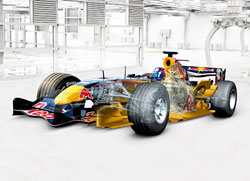Siemens helps make racing cars faster and Formula One factory more energy-efficient

Red Bull Racing entirely develops and manufactures its champion car using Siemens’ software for Product Lifecycle Management (PLM). The software forms the highly efficient digital backbone of the manufacturing process and enables new components to be designed at high speed on the computer, sent into production seconds later by mouse click and then built into the vehicle. This speeds up development and improves lap times. Source: Red Bull<br>
The software forms the highly efficient digital backbone of the manufacturing process and enables new components to be designed at high speed on the computer, sent into production seconds later by a mouse click and then built into the vehicle. This speeds up development and improves lap times.
“Siemens PLM software plays an important role within the company feeding data from our design engineers to our manufacturing facilities. This contribution should not be underestimated,” said Christian Horner, Team Principal of the Red Bull Racing team. In addition, Siemens is now reducing the energy consumption and CO2 emissions of the team’s factory buildings and production systems in Milton Keynes, England – making Red Bull Racing a pioneer in the racing world.
There is no industry where products have to be developed and manufactured as fast as they are at Formula One factories. And nowhere else where minimal changes in configuration can affect the entire performance of the car the way they can in Formula One. Victory and defeat are often only fractions of a second apart. During the brief periods between races, around 100 engineers at Red Bull Racing work under tremendous pressure every day, using Siemens’ software to make the cars driven by Sebastian Vettel and Mark Webber just that bit faster. The engineers virtually develop the entire vehicle, constantly design new components, assemble all 4,000 individual parts and put the vehicle through its paces – all while sitting at the computer. A mouse click is all it takes for the developers to have the new parts milled and moulded immediately – it is not necessary to enter any data by hand into the machine tools or other IT systems. By using the software Red Bull Racing has significantly reduced physical prototyping and limited material waste. Additionally, designers and manufacturing regained up to 75 percent of their time by eliminating tedious and repetitive portions of the design and manufacturing process.
To make the vehicle suitable for the various race tracks with their particular characteristics, many configurations are available. The engineers design and simulate the interplay of the parts on the computer to find the ideal combination. All the developers and engineers across the entire production facility can access all the data they need, whether in the factory or on the racetrack, at any time, and always know what was altered on the car.
Siemens is also optimizing Red Bull Racing’s factory with products from its Environmental Portfolio. The object is to significantly reduce the plant’s energy costs, resource consumption and CO2 emissions and also make the production processes more efficient. “An industrial company like Siemens is an ideal partner for optimizing production – with expertise accumulated from over 160 years of manufacturing, with 300 plants and the largest Environmental Portfolio in the world,” said Horner. Siemens is currently inspecting the entire production process, including all the existing machines and work processes. It is also carrying out an energy check on the building technology, heating and air-conditioning systems.
Siemens AG (Berlin and Munich) is a global powerhouse in electronics and electrical engineering, operating in the industry, energy and healthcare sectors. For over 160 years, Siemens has stood for technological excellence, innovation, quality, reliability and internationality. The company is the world’s largest provider of environmental technologies, generating some €28 billion – more than one-third of its total revenue – from green products and solutions. In fiscal 2010, which ended on September 30, 2010, revenue totaled €76 billion and net income €4.1 billion. At the end of September 2010, Siemens had around 405,000 employees worldwide. Further information is available on the Internet at: www.siemens.com.
Reference Number: AXX20101122e
Media Contact
More Information:
http://www.siemens.com/press/racingAll latest news from the category: Automotive Engineering
Automotive Engineering highlights issues related to automobile manufacturing – including vehicle parts and accessories – and the environmental impact and safety of automotive products, production facilities and manufacturing processes.
innovations-report offers stimulating reports and articles on a variety of topics ranging from automobile fuel cells, hybrid technologies, energy saving vehicles and carbon particle filters to engine and brake technologies, driving safety and assistance systems.
Newest articles

“Nanostitches” enable lighter and tougher composite materials
In research that may lead to next-generation airplanes and spacecraft, MIT engineers used carbon nanotubes to prevent cracking in multilayered composites. To save on fuel and reduce aircraft emissions, engineers…

Trash to treasure
Researchers turn metal waste into catalyst for hydrogen. Scientists have found a way to transform metal waste into a highly efficient catalyst to make hydrogen from water, a discovery that…

Real-time detection of infectious disease viruses
… by searching for molecular fingerprinting. A research team consisting of Professor Kyoung-Duck Park and Taeyoung Moon and Huitae Joo, PhD candidates, from the Department of Physics at Pohang University…





















